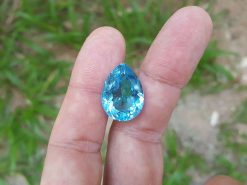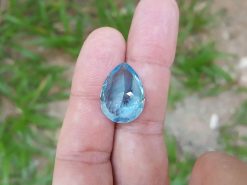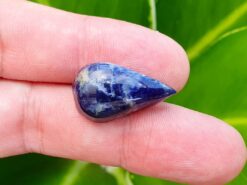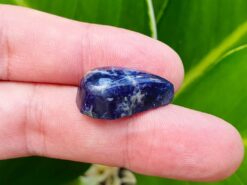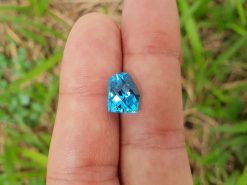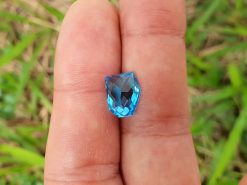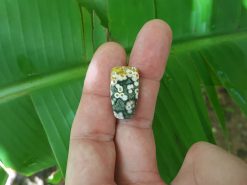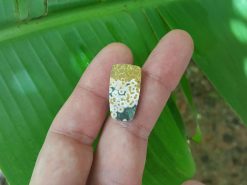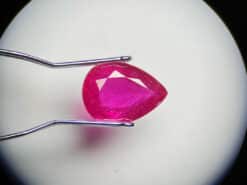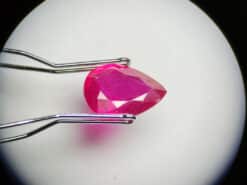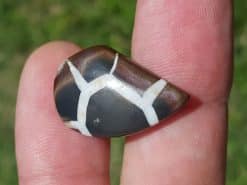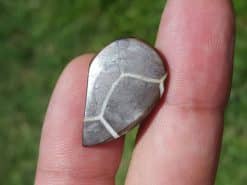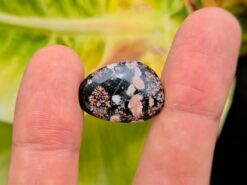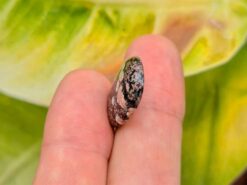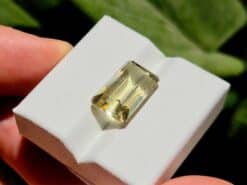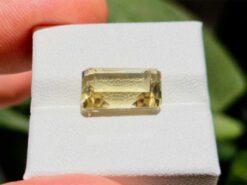Nephrite jade, from Russia
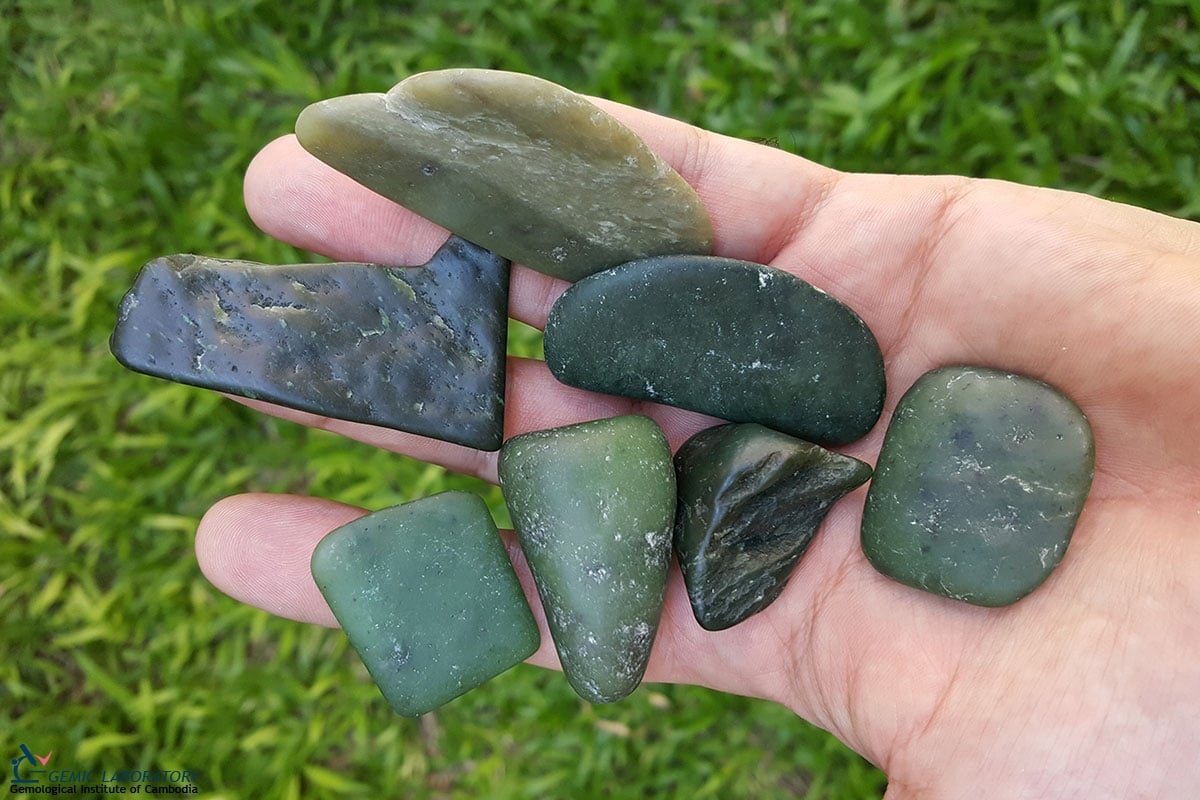
Buy natural gemstones in our shop
Nephrite Jade is a rock composed essentially of a variety of amphibole, actinote, of chemical formula Ca2 (Mg, Fe) 5Si8O22 (OH) 21. It is one of the two rocks called jade, the other being jadeitite, composed essentially of jadeite, a variety of pyroxene. Nephrite is an ornamental stone, used in a wide variety of jewelry or decorative objects. The name nephrite is derived from the Latin lapis nephriticus, translation of the Spanish piedra de ijada.
Nephritis can be translucent, white or very slightly yellow (called variety in China “fat jade sheep”), or opaque, white or very slightly brown or gray (variety called “jade bone chicken”) up to green, or present any nuances of green. Canada is the main producer of this fascinating stone.
Nephrite Jade was mostly used in China before the nineteenth century, in New Zealand, on the coasts of North America, in Neolithic Europe, and in Southeast Asia. Revered for its toughness and smooth luster, Nephrite Jade also carries cultural significance, having been used to create intricate carvings, ceremonial objects, and precious ornaments for centuries.
Russia
Green nephrite from Russia has gained a great reputation because of its bright color and good transparency. Both white and green nephrite are mined in Russia. Some of the white stones can be of equal quality to the most sought-after “mutton fat” jade and can be sold for high prices in China. Green nephrite is more readily available than the white varieties.
The first green nephrite boulders were discovered on riverbanks in Russia’s Sayan area in 1826. There were additional discoveries in 1851 along the Onot River. The first primary nephrite deposit was reportedly discovered in 1986.
Siberian nephrite mines are located in extremely remote areas of Russia, in the Eastern Sayan Mountains and the Dzhida areas to the southwest of Lake Baikal, along with the Parama massif to the northeast of the lake.
The Sayan Mountains are geographically and geologically related to the Altai Mountains that cross northwestern China, northern Mongolia, and southwestern Russia. Many people believe that this connection is the reason for the similar qualities of nephrite from China and Russia. In modern times, Russian Nephrite Jade has become highly sought after not only for its vibrant green hues but also for its durability and historical cachet.
Prehistoric and ancient China
The main sources of Nephrite Jade in Neolithic China were the now depleted deposits in the Ningshao area in the Yangtze Kiang Delta (Liangzhu culture, 3400-2250 BCE), as well as in an area of Liaoning Province and in Inner Mongolia (Hongshan culture, 4700-2200 BCE).
Jade was used to create many utilitarian and ceremonial objects, from interior decorations to the funeral costumes of the Han dynasty. It was considered the “Imperial Stone.”
From the earliest Chinese dynasty to the present day, the most exploited jades were those of the Khotan region of Xinjiang (other areas such as Lantian in Shaanxi were also in high demand). The white and green nephrites are small veins or are carried by the rivers running down the Kunlun Mountains to the Taklamakan Desert.
The harvest of the jade was concentrated on the Yarkand, the Yurungkash (or “White Jade River”) and the Karakash (“Black Jade River”). The Kingdom of Khotan, south of the Silk Road, paid China an annual tribute of white jades, considered to be more valuable than gold and silver, and were transformed into “objets d’art” by craftsmen attached to the imperial court.
Geological Formation and Characteristics
Nephrite Jade forms in metamorphic rocks through medium-grade metamorphism of certain minerals rich in magnesium and iron. Its fibrous, interwoven crystal structure makes it remarkably strong. This resilience is part of why it has been treasured for functional and decorative purposes throughout history. When cut and polished, Nephrite Jade displays a warm luster that ranges from waxy to vitreous.
Differences Between Nephrite Jade and Jadeite
Although both are referred to as “jade,” Nephrite Jade differs in mineral composition and appearance from jadeite. Nephrite has a softer, more fibrous makeup and often appears in diverse shades of green, brown, and white. Jadeite can exhibit a wider range of bright colors, but Nephrite Jade is typically prized for its classic, softer hues, incredible toughness, and ancient cultural heritage.
Historical Significance and Modern Use
Throughout history, Nephrite Jade has been associated with spiritual beliefs, social status, and artistic expression. Chinese emperors prized Nephrite Jade for its purity, linking it to virtues such as wisdom, compassion, and justice. In modern times, collectors and enthusiasts continue to seek out high-quality Nephrite Jade for both jewelry and ornamental carvings. Popular items include pendants, bangles, and intricately carved figurines that highlight the stone’s natural beauty.
Caring for Nephrite Jade
To maintain the beauty of Nephrite Jade, it is recommended to clean it gently with mild soap and water. Avoid exposing it to harsh chemicals or extreme temperatures, as this can damage its surface or alter its natural sheen. Storing Nephrite Jade pieces separately—especially jewelry—helps prevent accidental scratching and keeps each piece looking its best for generations.
Natural Nephrite Jade
Watch a short video below to see the captivating beauty of natural Nephrite Jade:
FAQ
How can I distinguish Nephrite Jade from synthetic imitations?
A reputable gemological test, often performed by a professional, will measure the specific gravity and analyze the mineral composition. Genuine Nephrite Jade has a distinctive fibrous structure and a certain heft due to its density.
Is Nephrite Jade more valuable if it is a deeper green?
Color plays a significant role in determining value, and a rich, even green hue can command a higher price. However, other factors—like clarity, texture, and overall appearance—also affect the final valuation of Nephrite Jade.
Q3: Can Nephrite Jade change color over time?
Generally, Nephrite Jade maintains its color well. However, it may look slightly different with prolonged exposure to oils or chemicals. Proper care, cleaning, and storage will help preserve its original color. Q4: Does Nephrite Jade have any special symbolic meanings today?
Yes. In many cultures, particularly in East Asia, Nephrite Jade is associated with harmony, protection, and balance. It is often used in talismans or jewelry thought to bring positive energy to the wearer. Q5: What factors affect the price of Nephrite Jade carvings?
The main factors are color consistency, translucency, craftsmanship, and overall aesthetics. Larger carvings or pieces that showcase intricate detailing can be highly prized and fetch premium prices among collectors.Natural gemstones for sale in our gem shop

